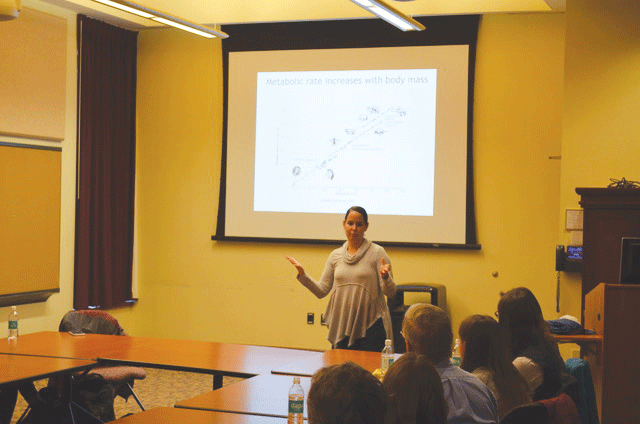Dr. Jimenez Speaks on her Research on the Biology of Aging in Dogs
Professor Ana Jimenez, pictured above, lectured on her research in the aging of dogs, and the impact of size on this process. There is little previous research on the answer to these questions.
On Monday, November 7, Assistant Professor of Biology Ana Jimenez gave the presentation, “The Biology of Aging: The Case of the Dog.” For the past two years, Jimenez has been collecting evidence concerning how dogs age. She has conducted her research with senior Josh Winward and alumna Ursula Beattie ’17. Additionally, Assistant Professor of Mathematics Will Cipolli assisted in Jimenez’s research.
In the introduction of her presentation, Jimenez mentioned the link between metabolism and aging in animals. Jimenez noted how metabolic rate increases with body mass. Mentioning a mouse as an example, Jimenez described that, because of body mass, a mouse has a smaller metabolic rate than, say, an elephant. Additionally, there is a trend Jimenez spoke of between body mass and mammals. The bigger a mammal is, the longer their life is. This is, however, not present in dogs. Instead, there is a trend that smaller dogs have a longer lifespan than that of a larger dog.
Jimenez continued her presentation by describing the anatomy of small and big dogs. Small dogs have small litters, which cause them to have a minor reproductive system, slow growth and a late maturity. On the other hand, larger dogs have large litters, causing them to have a more active reproductive system, faster growth, and early maturity. However, Jimenez noted the surprising trend that small dogs reach 50 percent of their adult weight quicker than larger dogs, but biggerdogs grow for longer and at a larger trajectory.
The introduction of metabolic rate was then brought up again to connect to the growth of dogs. Before doing so, Jimenez explained the two forms of metabolic rate: basal metabolic rate and mass specific metabolic rate. Basal metabolic rate is measured through an oxygen mask, whereas mass specific rate is measured through one gram per tissue. This is important because at the tissue and cell level, there are differences that can be compared between big and small dogs.
An interesting topic was reactive oxygen species, which can be seen in up to 15 percent of oxygen, and can contain damaging chemicals that can cause aging, and further detrimental effects on lipids, protein, DNA and joints. Related to oxidative stress, reactive oxygen species can affect oxidative stress through marking an imbalance in reactive oxygen species and in a biological system’s capabilities in attempting to suppress the toxins damaging cells. In dogs, large breeds tend to have smaller antioxidant capacity, meaning that they have less resources in trying to prevent oxidative stress from causing damage. Smaller breeds, however, have a larger antioxidant capacity. This relates to aging because smaller dogs are less likely to receive damage to their biological system as compared to larger breeds, which are more likely to be negatively affected by reactive oxygen species and intake diseases, such as cancer.
As defined by Jimenez, aging is the malfunction of most systems. In order to find a trend within dogs in an experimental setting, four groups were created for her experiment with the variables of size and age, including both young and senior small breed dogs and young and senior large breed dogs. Oxygen consumption rate and glycolysis were measured. It was determined that small dogs lived longer because they had a smaller production of reactive oxidative species than larger breeds. Because larger breeds of dogs suffer more from oxidative stress, this causes significantly larger damage in DNA and basal lipid peroxidation. These detrimental effects in large dogs causes them to be highly susceptible to diseases and injury, which explains their shorter lifespan to that of small dogs.
Not much research has been done to measure aging in dogs besides her research. This unique topic highlights the perplexity of aging, however, further attention to this matter can result in unforeseen achievements in science. Jimenez’s research has already been reported on by academic journals such as Science Magazine.
Students attending the lecture reacted positively to Jimenez’s research.
First-year Jake Bilodeau, remarked how “different, yet important” her presentation was and said that he was interested in future implications of her work.
“[In the future it may be possible to see] advancements in preventing cells from aging,” Bilodeau said.
First-year Andrew Blum noted how Jimenez’s work has influenced the field.
“More research should be done on cell aging. [Research on cells and aging] can have important medicinal uses,” Blum said.
Jimenez felt that while the two years she spent on the research were valuable, she is still interested in learning more on the topic.
Contact Finn Schuemann at [email protected].




